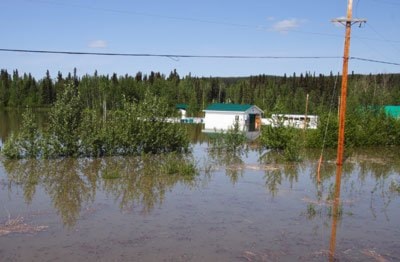Within a month, Upper Liard residents will know whether they will have to evacuate their homes for the third year in a row.
The 10 households that sit between the banks of the Liard River and the Alaska Highway just west of Watson Lake have been repeatedly ignored by government as they demand a permanent dike that can withstand the river’s spring deluge.
So far, the community has only received temporary sandbags, money to repair water damage and ministerial visits that brought little action.
“It’s money that’s basically wasted,” said Jean Legare, a hunter and trapper in the tightknit hamlet.
“It’s ridiculous to come and fix the houses but not cure the cause,” he said.
The Liard River is known to have a 20-year flood cycle, but lately the high water in the spring has become more frequent.
“Four of the last five years will be in the top 10 since they’ve been keeping a record,” said Legare.
While the first snowpack survey doesn’t come out until March 1, the initial news doesn’t look good.
“The preliminary information indicates that snowpack in Whitehorse, Upper Yukon and in Liard is somewhat above average,” said Richard Janowicz, the manager of hydrology in the Environment Department.
It is a little early to predict with much certainty, he said. “But in another month, we’ll know.”
Long-term trends show that precipitation in the Yukon has been lowering in the winter, but summer precipitation has been increasing. The Liard floods happen in June, usually with torrential rain hitting the area.
If snowpack is melting just as more precipitation is coming down, it’s a “perfect-storm scenario,” said Janowicz.
The recent wave of heavy flooding began in the spring of 2007, when the small dirt bank that was built in 1990 did nothing to stop the rising Liard.
The computer program Google Earth was the only thing to notice.
The satellite photographs of Upper Liard were coincidentally taken during the time of the flood. The images show large swaths of land covered with the Liard’s murky waters.
Blue, white and silver rooftops pepper the slim wedge of land where many retirees make their summer home.
The flooding went unreported in the media and the Emergency Measures Organization “didn’t even know (Upper Liard) existed,” said Legare. Their immediate response was “absolutely nothing,” he said.
But a week later, they did come with a flat-bottomed river boat.
One emergency worker offered Legare an apology and told him that the community had been “abandoned.”
Downriver in Lower Post, British Columbia, authorities built 800 metres of dike in 48 hours, said Legare. The two homes on the other side of the river where First Nations live also had a dike built after the 2007 flooding.
The minister in charge of the Yukon Housing Corporation, Jim Kenyon, flew over the flood in a charter plane to observe the damage, he said.
“They said, ‘Yeah, it’s flooded’ and then Kenyon had to go back to Whitehorse because there was a banquet that day,” he said.
“Fentie drove by and never stopped,” said Legare. “We never saw or heard from Fentie and he’s our MLA.”
The cost to repair the homes was around 0,000, he said. Three homes were destroyed and another was severely damaged.
The money came from Ottawa but is administered by the housing corporation, he said. An official with the corporation couldn’t confirm before press time.
“If it floods again, that work was done for nothing,” said Legare. “Building a dike is a one-time cost that would solve all the problems together.”
There was minor flooding in 2007 but the community still had to evacuate. The response from Emergency Measures was swifter this time, with Minister Glenn Hart visiting and some sandbags on the ground.
“When there’s a disaster, (Emergency Measures Organization) drops everything and comes to get it done,” he said. “It’s always done as a knee-jerk reaction, there’s no planning.”
“Any work (Emergency Measures) does is temporary.”
There was a report last year that was meant to address the 2007 flooding but it’s practically useless, said Legare.
“They don’t have a survey, it’s just a report on paper,” he said.
“They’ve done aerial photos to interpret the land. They don’t know the difference in elevation between the river and the land and the proper flow of the river.”
It only recommends a plan be drawn up by the federal and territorial government to build a dike.
“Given the magnitude and scope of work, over $1 million, that would typically need budget approval, and that would be subject to cabinet approval,” said Community Services infrastructure director Kriss Sarson in November..
It’s a worthy investment when the estimated cost of the 2007 flooding was said to be $644,000 to $1,281,000 in the same report.
Residents wrote a letter to Community Services Minister Archie Lang, asking what the situation is on August 22 but they still haven’t received an answer and his office doesn’t return phone calls.
“What I want is Archie to take it seriously and do something as soon as the snow goes,” said Legare.
Some of the new infrastructure money promised from Ottawa could easily do the trick, he said.
In the meantime, the families and retirees of Upper Liard try to calm their nerves.
“That’s all I’ve been thinking of for the last week,” said Legare. “I might lose my house this year.”
Contact James Munson at
jamesm@yukon-news.com.
